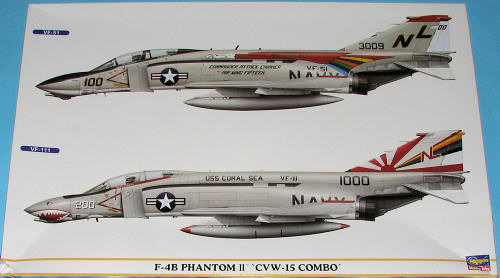
Hasegawa 1/72 F-4B Phantom II "CVW-15 Combo"
| KIT #: | 00956 |
| PRICE: | $85.00 SRP ($63.95 at www.greatmodels.com ) |
| DECALS: | Two options |
| REVIEWER: | Scott Van Aken |
| NOTES: | Limited reissue with new decals |

| HISTORY |
The first full series production version of the Phantom II was the F-4B. Yes, there were F-4As, but those were pre-production types, or mostly used by the two training squadrons; VF-101 and VF-121 as well as by various test units.
The F-4B was the first fleet squadron capable aircraft and was what went to war in Vietnam with USN units. Later in life, most of those were upgraded to F-4N standards that included upgraded avionics and in some cases, better engines. The easiest way to tell an F-4B from an F-4N is that the N model has long ESM antennas along the upper intake. Some F-4B and F-4N aircraft were modified for drone duty as QF-4B and QF-4Ns. The rest were either lost in operations used for display planes (some of them wearing USAF colors and serials), or scrapped. There may still be a few in the boneyard.
| THE KIT |
 The king of reissues has done a nice one this time. Two 1/72 scale early USN Phantoms in one box. This time, the planes are from CVW-15 and have two of the most desired CAG finishes ever applied to this aircraft. Both of these are USS Coral Sea based. One is the 'supersonic canopener' scheme from VF-51 while the other is the 'sunburst' scheme from VF-111.
The king of reissues has done a nice one this time. Two 1/72 scale early USN Phantoms in one box. This time, the planes are from CVW-15 and have two of the most desired CAG finishes ever applied to this aircraft. Both of these are USS Coral Sea based. One is the 'supersonic canopener' scheme from VF-51 while the other is the 'sunburst' scheme from VF-111.
When one opens the box, the only thing one sees that is new (aside from two complete kits), is an addendum instruction sheet and a large decal sheet. The kit is your standard Navy F-4 kit that has been around for 20 years. It has held up quite well as I found little in the way of flash, quite a feat as parts of this kit must have been cranked out hundreds of thousands of times over the years. The assembly instructions you get are for kit KX 3 which was one that had VF-111 and several other units for decals. You can pretty well follow these without fail except for the upper fuselage antennas. This boxing provides an addendum sheet that shows more than decals, it also shows which upper fuselage antenna suite to use with each plane.
 Anyway, instructions are typical Hasegawa and provide your standard, and now getting difficult to find in the US, Gunze paint references. The sheet has decals for the instrument panel and side consoles as well as for the anti-glare area in front of the windscreen (for the VF-111 plane. You'll have to paint it on the VF-51 bird) and the upper intake wing walk areas. Hasegawa has also provided the option to paint the fins or rudder on the markings of your choice if you don't want to use the ones that are with the decal. It is nice to have options like this. The sheet is very nicely printed and of the new style so should be a delight to use. Both planes are, of course, in the light gull grey over white scheme. I would go with matte for the upper surface color as these are pre-changeover schemes. In the early 1970s, they switched to gloss polyurethane for the upper scheme, a paint that was much easier to keep clean. These also show the slotted stabilators as provided on the later production B models and retrofitted to earlier builds.
Anyway, instructions are typical Hasegawa and provide your standard, and now getting difficult to find in the US, Gunze paint references. The sheet has decals for the instrument panel and side consoles as well as for the anti-glare area in front of the windscreen (for the VF-111 plane. You'll have to paint it on the VF-51 bird) and the upper intake wing walk areas. Hasegawa has also provided the option to paint the fins or rudder on the markings of your choice if you don't want to use the ones that are with the decal. It is nice to have options like this. The sheet is very nicely printed and of the new style so should be a delight to use. Both planes are, of course, in the light gull grey over white scheme. I would go with matte for the upper surface color as these are pre-changeover schemes. In the early 1970s, they switched to gloss polyurethane for the upper scheme, a paint that was much easier to keep clean. These also show the slotted stabilators as provided on the later production B models and retrofitted to earlier builds.
| CONCLUSIONS |
So there you have it, another fine boxing by Hasegawa and one that provides a pair of the world's greatest jet fighter. If you don't like the scheme, there are enough extra bits to do just about any F-4B for which you can find a reference photo. You'll also have to break out the wallet for Sidewinders and Sparrows as Hasegawa does not provide those. But you knew that already.
September 2009
You can get this kit and many other fine kits and accessories at www.greatmodels.com. Check them out for sale items as well.
If you would like your product reviewed fairly and fairly quickly, please contact the editor or see other details in the